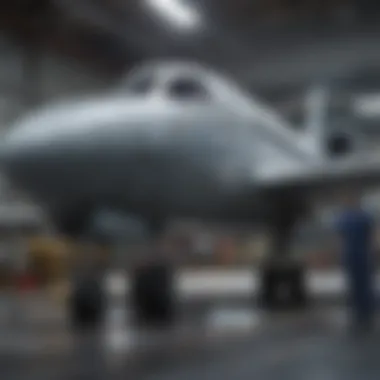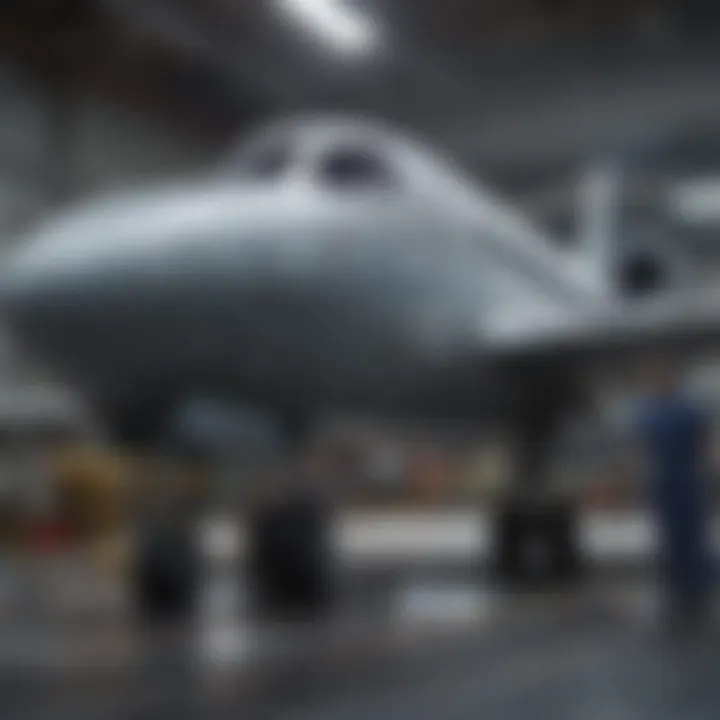Aircraft Maintenance Patches: An In-Depth Overview


Summary of Objectives
This article delves into the realm of aircraft maintenance patches, elucidating their multifaceted role in aviation safety and operational performance. We aim to address the purpose of these patches, the variety available, their application methods, and the regulatory frameworks guiding their use. Additionally, the discussion extends into future prospects for innovations in this field.
Importance of the Research
Understanding aircraft maintenance patches is critical for maintaining aircraft integrity. In-depth knowledge equips industry professionals, researchers, and students with evaluation tools necessary for selecting and implementing appropriate patch solutions. As aviation evolves, keeping abreast of advancements ensures adherence to safety standards and enhances efficiency.
Intro
Aircraft maintenance patches form an essential aspect of aerospace operations. Their primary purpose is to ensure that aircraft meet safety and reliability standards over time. These patches can be used for both structural and cosmetic repairs. The relevance of correctly applying and maintaining these patches cannot be understated, as they play a vital role in preventing more severe issues down the line.
The rising complexity of aircraft technology necessitates a careful look at how these patches are developed and applied. Understanding the types, materials, and innovations surrounding aircraft maintenance patches allows for informed decision-making.
Types of Patches
Aircraft maintenance patches can be categorized into several types, each suited for specific applications. Some common types are:
- Composite patches: Often used for lightweight aircraft, they help in reducing weight while providing durability.
- Metal patches: Typically used on older aircraft, they provide strength where it is needed most.
- Adhesive patches: These are gaining popularity due to their ease of application and effectiveness.
Understanding these different types is crucial for selecting the right patch based on specific needs, including material compatibility and operational environment.
Application Methods
Proper application methods are vital for the efficacy of patches. Key application methods include:
- Surface Preparation: Cleaning the area to be patched ensures that the adhesive bonds well.
- Adhesive Application: Choosing the correct adhesive based on the patch type and material is crucial.
- Pressure Application: Applying adequate pressure helps ensure a strong bond, which may require special tools.
Employing these methods systematically contributes to the operational longevity of the aircraft.
Regulatory Standards
Adhering to regulatory standards is not just a best practice; it is a requirement in aviation maintenance. Regulations set forth by governing bodies such as the Federal Aviation Administration (FAA) provide guidelines on how patches should be applied and maintained. Folllowing these standards is necessary to ensure all repairs meet the safety and performance expectations laid out by the industry.
Future Innovations
With aerospace technology advancing rapidly, innovations in maintenance patches are expected. Research and development focus on creating materials that are not only lightweight but also stronger. For instance, the development of self-healing materials promises a future where minor damages may auto-correct, minimizing the need for manual patching altogether.
"Emerging technologies could redefine what we expect from aircraft maintenance patches, enhancing overall aircraft reliability."
Prelude to Aircraft Maintenance Patches
Aircraft maintenance patches play an essential role in ensuring the safety and operational efficiency of aircraft. Their significance extends beyond mere repair to being integral to the structural integrity of planes. As aircraft undergo wear and tear from operational stresses, it becomes crucial to address damage swiftly. Patches serve as both temporary and permanent solutions to various forms of damage, ensuring that aircraft remain airworthy and compliant with safety regulations.
Definition and Importance
An aircraft maintenance patch is a material or product used to cover or repair structural damage on an aircraft's surface. This could be minor surface abrasions or more significant structural issues. The purpose of these patches is to restore the aircraft's integrity, preventing further degradation and potential failures during flight.
The importance of maintenance patches can be summarized in a few key areas:
- Safety: Patches help maintain the structural integrity of the aircraft, which is vital for flight safety.
- Cost efficiency: Properly applied patches can extend the lifespan of an aircraft component, thus reducing the overall maintenance costs.
- Regulatory compliance: Many aviation regulations mandate that any damage must be addressed promptly. Using patches can help meet these regulatory standards.
Historical Context
The use of patches in aircraft maintenance has evolved significantly since the early days of aviation. In the beginning, maintenance practices were rudimentary, relying mostly on metal rivets and simple repairs. Post-World War II, the complexity of aircraft increased with advancements in materials and design.
In the 1960s, the introduction of composite materials led to a new wave of patch technologies. These advancements not only improved the repair process but also offered better performance characteristics. Regulations began to reflect these changes, enforcing stricter guidelines for the use of patch materials and methods.
As aviation technology progresses, the techniques and materials used in aircraft maintenance patches continue to advance. Understanding this historical context is essential for appreciating present practices and innovations in the field.


"The evolution of aircraft maintenance patches reflects the ongoing commitment to safety and efficiency in aviation."
Types of Aircraft Maintenance Patches
Aircraft maintenance patches play a crucial role in ensuring the safety and integrity of an aircraft. Understanding the different types of patches is essential for effective maintenance strategies. This knowledge allows professionals to choose the appropriate patch for various situations, enhancing aircraft performance and operational longevity. The differentiation between types is based on factors such as the duration of use, materials, and the specific needs imposed by damage type.
Temporary vs. Permanent Patches
Temporary patches are intended for short-term fixes. They are usually applied in situations where immediate action is needed, for instance, during flight delays or on-site repairs. With temporary patches, the focus is on restoring functionality quickly rather than achieving a long-lasting solution. While they can be effective, the longevity and performance may be limited. In contrast, permanent patches are designed for long-term applications. These patches undergo rigorous testing and are often subjected to strict regulatory standards. Choosing between temporary and permanent patches requires considering factors such as the severity of damage, required durability, and regulatory compliance.
Material-Based Classifications
Composite Materials
Composite materials are becoming increasingly popular in aircraft maintenance. Their lightweight nature and high strength make them an excellent choice. Composites often consist of a combination of materials, which contribute to enhanced durability and corrosion resistance. One key characteristic of composite materials is their ability to withstand varying environmental conditions, making them suitable for long-term applications. However, proper installation is critical to prevent issues such as delamination.
Metallic Patches
Metallic patches are traditional in aircraft maintenance. They are favored for their robustness and structural integrity. These patches often use aluminum or titanium, materials that offer strength and resistance to environmental factors. A primary advantage of metallic patches is their proven track record and ease of sourcing. However, they can be heavier than alternatives, which might affect overall aircraft performance. Additionally, metallic patches may require precise installation techniques to ensure optimal adhesion and prevent corrosion.
Adhesive-Based Solutions
Adhesive-based solutions provide versatile options for patching. These solutions allow for flexible applications on various surfaces, adapting to the shape and contours of the damaged area. One significant characteristic is that they tend to bond exceedingly well to both metallic and composite substrates. These adhesives can improve the maintenance process by reducing the need for drilling or fasteners. However, potential downsides include vulnerability to temperatures and solvents that could compromise the bond over time. Addressing these challenges is crucial for maintaining the efficacy of adhesive patches.
"Selection of the right aircraft maintenance patch material is vital in ensuring both safety and efficiency."
Application Methods for Aircraft Patches
The application methods for aircraft maintenance patches play a critical role in ensuring the functionality and longevity of the repairs. Proper techniques lead to enhanced durability, reliability, and safety of the aircraft. The chosen application method can significantly affect the performance of the patch, so understanding these processes is essential for both practitioners and researchers. This section examines the techniques involved in preparing and installing patches, emphasizing their importance within aircraft maintenance operations.
Surface Preparation Techniques
Surface preparation is the foundational step in the patching process. It determines how well the patch adheres to the aircraft's surface. Any contaminants, like dirt, grease, or corrosion, can hinder adhesion and diminish the effectiveness of the repair. Thus, it is crucial to ensure a clean, smooth, and suitable surface for patch application. Various techniques are utilized depending on the type of damage and patch material:
- Cleaning: Use solvents or detergents to remove contaminants. It is vital to follow manufacturer guidelines regarding the cleaning agents.
- Sanding or Abrading: This mechanical process helps in smoothing the surface, especially if the area has sustained surface damage. It increases surface area for adhesion.
- Degreasing: In situations where oils or greasy residues are present, a specialized degreasing agent should be employed for effective cleaning.
The steps in surface preparation are not merely procedural but crucial in achieving long-lasting outcomes. Missing this stage can have significant repercussions, leading to patch failure or aircraft safety issues.
Installation Procedures
Once the surface has been adequately prepared, the installation of the aircraft patch follows. Proper installation ensures that the patch functions as intended and provides safety for the aircraft during operation. Here are some key steps in the installation procedure:
- Applying Adhesive: Depending on the patch type, an appropriate adhesive is applied uniformly to the patch or the aircraft surface. Care should be taken to use the right amount to avoid squeezing it out during placement.
- Positioning the Patch: The patch must be placed accurately over the prepped area. Proper alignment is necessary for full coverage of the damaged region.
- Pressurizing the Patch: Depending on the adhesive's specifications, it may require pressing the patch for a period to ensure a secure bond. Use of tools like rollers or clamps can help here.
- Curing Time: Allow the adhesive to cure for the specified time as per manufacturer instructions. Premature use of the patched area can weaken the bond.
- Inspection and Testing: After installation, a thorough inspection is critical. This can involve visual checks and any additional testing methods to ensure performance under operational conditions.
Effective installation procedures not only ensure the immediate success of the patch application but also contribute to the long-term integrity of the aircraft. Improper techniques can lead to serious complications later on, reiterating the need for adherence to established practices.
"Failure in patch integrity can compromise the entire aircraft's safety, making rigorous application methods essential."
Understanding the nuances of surface preparation and installation procedures is fundamental for anyone involved in aircraft maintenance. Mastery of these processes ensures that aircraft patches serve their purpose effectively, thereby enhancing flight safety and operational performance.
Regulatory Standards and Compliance
Regulatory standards and compliance are crucial in the context of aircraft maintenance patches. They ensure that patches meet safety and performance criteria, ultimately protecting both aircraft integrity and passenger safety. Without these regulatory frameworks, there would be significant risks to operational efficiency and safety, as unverified patches could lead to catastrophic failures during flight. Therefore, compliance not only serves as a legal requirement but also as a benchmark for quality assurance.
These standards help in guiding manufacturers and maintenance personnel in the choice of materials, types, and application methods for patches. Adherence to regulations fosters trust among stakeholders in the aerospace industry, including aircraft manufacturers, regulatory bodies, and maintenance operators.
Moreover, compliance with these standards impacts the economic aspects of aircraft maintenance. It ensures that patches will last longer and perform their intended function without constant need for replacements or repairs. This cost-effectiveness can significantly influence the budgeting decisions of aviation companies.
FAA Regulations
The Federal Aviation Administration (FAA) regulations play a vital role in the oversight of aircraft maintenance practices in the United States. The FAA sets guidelines that ensure all maintenance conducted on aircraft, including the application of patches, meets stringent safety and technical standards. These regulations specify that any patch used must be approved for the intended purpose, thus minimizing the risk of failure.


Key aspects of FAA regulations include:
- Material Specifications: Detailed requirements for materials that can be used for patches.
- Testing Requirements: The need for patches to pass certain testing protocols to confirm their reliability under different environmental conditions.
- Documentation: Mandatory archiving of maintenance records, demonstrating compliance with regulations and the effectiveness of applied patches.
Following these FAA guidelines is not just about avoiding penalties; it is about ensuring safety in aviation operations.
EASA Guidelines
The European Union Aviation Safety Agency (EASA) also plays a significant role in regulating aircraft maintenance patches, particularly within Europe. EASA’s guidelines parallel many aspects of FAA regulations but also account for regional differences in aviation standards. These guidelines are meticulously designed to enhance safety and reliability in the aviation sector.
EASA guidelines cover several important areas, such as:
- Certification of Patch Materials: Ensuring all materials used for patches are tested and certified by accredited laboratories.
- Performance Testing: Similar to the FAA, EASA demands rigorous performance testing to evaluate how patches hold up under various conditions.
- Continuous Oversight: EASA procedures involve ongoing monitoring of compliance through audits and inspections, reinforcing accountability.
Understanding and complying with EASA regulations is critical for any company operating within Europe to maintain operational legitimacy and ensure the safety of their aircraft.
Factors Influencing the Selection of Patches
The choice of aircraft maintenance patches plays a pivotal role in ensuring the safety, functionality, and longevity of aircraft. Numerous factors must be considered to select the most appropriate type of patch for specific situations. These elements not only affect the immediate repair but also have implications for the aircraft's overall performance and regulatory compliance. In this section, we will examine critical factors influencing the selection of patches.
Type of Damage
The first consideration when selecting a patch is understanding the nature of the damage. Different types of damage, whether it is fatigue cracks, corrosion, impacts, or structural deformations, require distinct approaches. For example, fatigue cracks often require high-strength patches capable of sustaining large loads. In contrast, a minor superficial issue due to external factors may be adequately addressed with a lighter material. The correct alignment of the patch with the type and extent of damage determines its success. An incorrect selection can lead to further complications, potentially affecting operational safety.
Environmental Considerations
Environmental conditions significantly impact the choice of maintenance patches. Factors such as humidity, temperature extremes, and exposure to chemicals must be accounted for during selection. For example, areas prone to high moisture content require patches with high corrosion resistance. Moreover, for aircraft operating in deserts, dust and sand can accelerate wear and tear, making durable materials a prerequisite. Utilizing materials designed to withstand specific environmental challenges ensures that patches maintain their adhesion and structural integrity over time.
Cost-Benefit Analysis
Finally, conducting a thorough cost-benefit analysis is essential when selecting patches. The initial cost of patch material might be low, but the longevity and performance potential must also be considered. Investing in higher-quality patches may yield long-term benefits through reduced maintenance needs and improved safety standards. Moreover, operational downtime related to ineffective patches can lead to significant financial losses. Therefore, weighing short-term savings against the potential for long-term advantages is crucial for making an informed decision.
In summary, understanding the type of damage, evaluating environmental factors, and conducting a proper cost-benefit analysis are crucial for selecting effective aircraft maintenance patches.
By carefully considering these factors, repair professionals can ensure that the maintenance patches selected will provide immediate solutions and withstand the test of time.
Efficacy and Performance of Aircraft Patches
The efficacy and performance of aircraft maintenance patches are critical factors in ensuring that these solutions effectively restore and maintain the structural integrity and safety of aircraft. In this section, we will explore various testing methods that validate the performance of patches, along with real-world case studies that highlight their practical implications. Understanding these elements can provide valuable insight for professionals involved in aircraft maintenance.
Testing Methods
Testing methods play a crucial role in determining how well aircraft patches perform under different conditions. Two prominent testing methods include static load testing and fatigue testing. Both offer unique advantages and insights into the reliability of patches used in aviation.
Static Load Testing
Static load testing evaluates how well a material can support a load without any movement or deformation over time. This type of testing is essential in the context of aircraft patches because it helps to understand how patches behave under fixed, non-dynamic conditions. The key characteristic of static load testing is its ability to simulate emergency situations where an aircraft might undergo sudden stress. This makes it a beneficial choice for assessing the initial integrity of a patch.
One unique feature of static load testing is that it can realistically assess the adhesive properties of different materials, which is particularly important when selecting patches made from various composites. However, a disadvantage of static load testing is that it does not fully replicate the multi-directional stress experienced during actual flight. Hence, while it provides critical data, it should ideally complement other testing methods.
Fatigue Testing
Fatigue testing focuses on the durability and performance of materials subjected to cyclic loads over time. In aviation, this testing is vital as aircraft endure repetitive stresses during flight operations. The key characteristic of fatigue testing is its ability to reveal how patches hold up under conditions that mimic real-world use. This makes it a popular choice for validating long-term efficacy and reliability.
A unique feature of fatigue testing is that it allows for the evaluation of not just immediate performance but also how materials may degrade over time. This is crucial for ensuring that patches will continue to function as intended throughout their service life. However, fatigue testing can be more complex and time-consuming than static load testing, which may present challenges in resource allocation for maintenance teams.
Real-World Case Studies
Real-world case studies provide invaluable insights into the actual performance of aircraft patches in operational environments. These cases often illustrate the practical benefits of applying specific maintenance patches, showcasing their long-term impact on aircraft safety and efficiency. By examining these case studies, professionals can make more informed decisions about selecting and applying patches to ensure the integrity of their fleet.


In summary, understanding the efficacy and performance of aircraft patches through rigorous testing and real-world applications can lead to better maintenance practices and enhanced aircraft reliability. These evaluations are foundational for ensuring the safety and efficiency of aviation operations.
Challenges in Aircraft Maintenance Patches
Understanding the challenges associated with aircraft maintenance patches is critical for ensuring the safety and effectiveness of these essential components. Every patch application has its own potential complications that can affect the integrity of the aircraft and ultimately, the safety of its operations. Effectively addressing these challenges is paramount for maintenance personnel and engineers alike, as it impacts operational efficiency and aircraft reliability.
Adhesion Issues
Adhesion is a major concern when it involves aircraft maintenance patches. The effectiveness of patches primarily relies on their ability to adhere properly to the aircraft surface. Some factors can influence adhesion quality:
- Surface Contamination: Dirt, oil, or moisture on the surface can drastically reduce adhesive strength.
- Material Compatibility: Different materials have various coefficients of expansion, which can be a problem in extreme temperatures.
- Application Technique: Improper application can leave air bubbles or misalignments, leading to premature failure.
Thus, maintaining an optimal environment and following strict protocols during application is essential to ensure solid adhesion. Successful patching relies heavily on thorough surface preparation. Ideally, each maintenance team must be well-trained and familiar with the specific materials and techniques needed for achieving maximum adhesion.
"Proper adhesion is critical for the long-term success of aircraft maintenance patches. Failure at this stage can render the patch ineffective, compromising safety."
Long-Term Efficacy
The long-term efficacy of patches is another significant consideration. Over time, various factors can impact the performance of maintenance patches:
- Environmental Exposure: Sunlight, temperature fluctuations, and humidity can deteriorate materials used in patches.
- Mechanical Stress: Regular stress from flight operations can weaken the patch, especially if not regularly inspected.
- Material Degradation: The aging process of the patch materials can lead to loss of mechanical properties.
Regular assessment of patches is essential in prolonging their lifespan and efficacy. Maintenance teams should establish a comprehensive schedule for inspections to monitor the condition of existing patches. If any defects are detected early, remediation can be addressed before they escalate into significant safety concerns.
By focusing on adhesion issues and long-term efficacy, maintenance personnel can enhance the reliability of patches. Thorough understanding of these challenges lays the foundation for effective patch management and fosters operational safety in aviation.
Future Innovations in Aircraft Maintenance Patches
In the ever-evolving field of aerospace engineering, future innovations in aircraft maintenance patches hold significant promise for enhancing maintenance practices and aircraft performance. Innovations in materials and methods directly impact the safety, efficiency, and longevity of aircraft operations. As the demand for higher safety standards and reduced downtime increases, the focus on advanced patching technologies becomes crucial.
Smart Materials
Smart materials represent a transformative approach in aircraft maintenance. These materials have the ability to respond to environmental changes, such as temperature and stress. For example, the integration of materials that can alter their properties under varying conditions is vital. This flexibility means that patches can adapt to the stresses they encounter in service, which improves their durability and reduces the likelihood of failure.
The benefits of smart materials include:
- Enhanced Reliability: By adapting to changing conditions, smart patches can maintain their functionality longer than traditional options.
- Weight Reduction: Lightweight smart materials contribute to overall aircraft efficiency, enhancing fuel economy.
- Maintenance Prediction: Certain smart materials can signal wear or degradation, allowing for proactive maintenance before serious issues arise.
When considering smart materials, manufacturers must evaluate their performance in real-world conditions. The continuous development of nanotechnology and biomimetic approaches offers exciting possibilities. With careful research, smart materials can provide robust solutions that meet the rigorous demands of modern aviation.
3D Printing Applications
The advent of 3D printing technology has revolutionized the manufacturing landscape, and the aircraft maintenance sector is no exception. 3D printing allows for the on-demand production of maintenance patches tailored to specific requirements. This ability can significantly reduce turnaround times for repairs, ensuring that aircraft return to service more quickly.
Notable applications of 3D printing in aircraft patches include:
- Customization: Each patch can be designed to fit unique damage profiles, optimizing effectiveness.
- Material Diversity: A wide range of materials can be utilized in 3D printing, including composites and metals, to best suit the need.
- Cost Efficiency: Producing patches as needed eliminates inventory costs and reduces waste, contributing to sustainable aircraft maintenance practices.
Integrating 3D printing into maintenance strategies also enables rapid prototyping of patches for testing. The iterative design process allows engineers to modify and optimize patch characteristics efficiently. As more innovations arise in 3D printing technology, the potential for aircraft maintenance patches will likely expand, leading to ongoing improvements in the field.
"The future of aircraft maintenance lies in innovation, with smart materials and 3D printing promising enhanced safety and efficiency at every level."
In summary, as advancements in smart materials and 3D printing technology continue to unfold, the future of aircraft maintenance patches aims to improve aircraft integrity and operational efficiency comprehensively. Engaging with these innovations will require a commitment to research and development, as well as collaboration among industry stakeholders.
Ending
The conclusion of this article on aircraft maintenance patches serves as a crucial reflection on the significant points discussed throughout. Aircraft maintenance patches play an indispensable role in ensuring the structural integrity and operational efficiency of aircraft. Understanding their importance is not merely about acknowledging the presence of such patches but diving into the multifaceted benefits they provide.
Summary of Key Points
In summary, the considerations about types of patches, including temporary versus permanent solutions, underscore the necessity of selecting the correct type based on specific requirements. The materials used, such as composite materials, metallic patches, and adhesive-based solutions, directly influence both the efficacy and longevity of patches in service.
Additionally, the discussed application methods highlight the importance of proper installation techniques and surface preparation, which are foundational to achieving desired outcomes. Regulatory standards set forth by authorities like the FAA and EASA ensure compliance and safety, further solidifying the credibility of maintenance practices across various aviation sectors.
Future Directions for Research
Looking ahead, there is a pressing need for continued research and innovation in the field of aircraft maintenance patches. Areas such as smart materials could revolutionize how patches respond to environmental changes and stresses. Likewise, the application of 3D printing technology offers exciting possibilities for producing custom patches tailored to specific types of damage, enhancing repair efficiency and effectiveness. Research must also focus on long-term studies to assess the durability and performance of newly developed patches under varying operational conditions.













